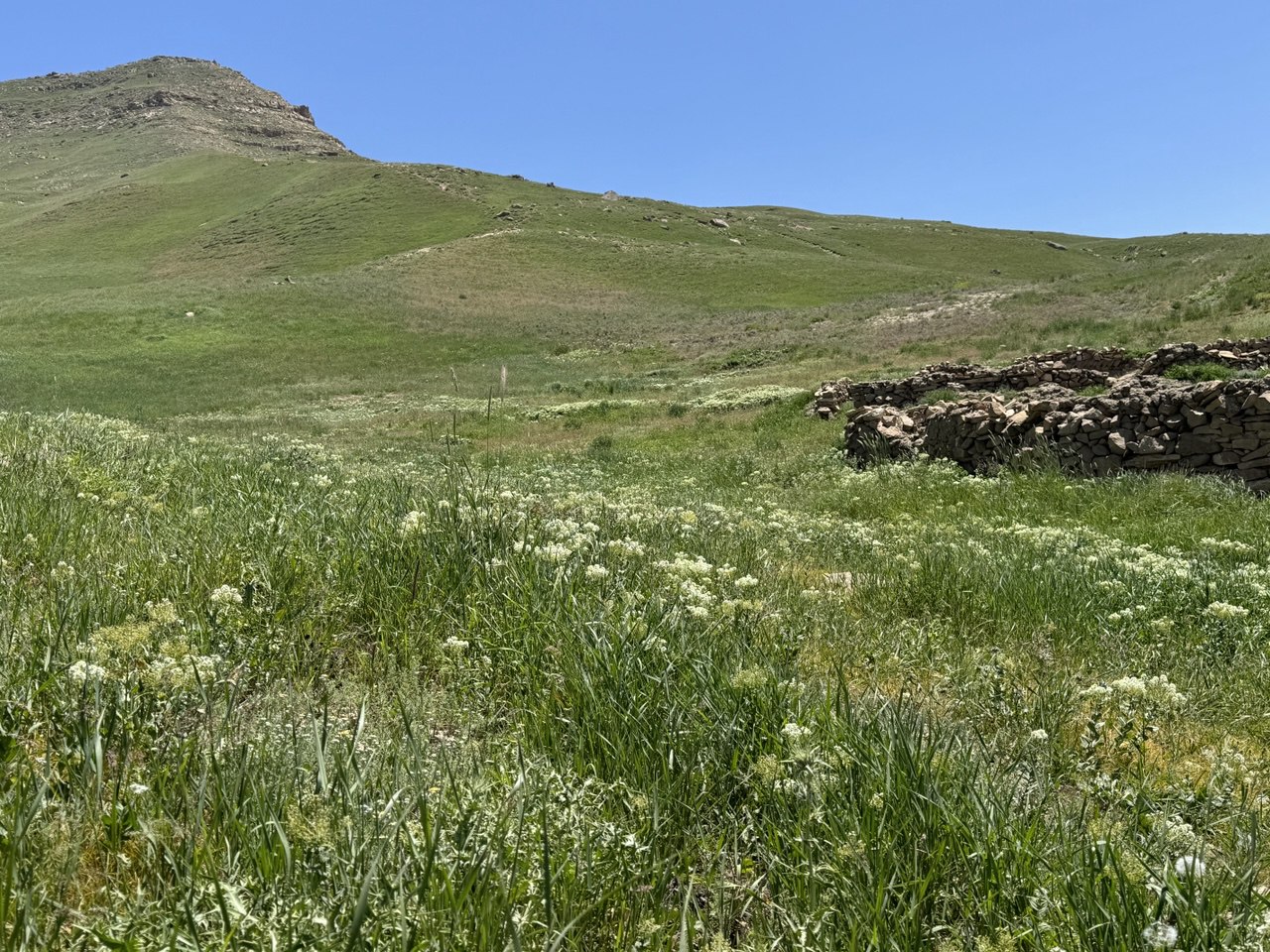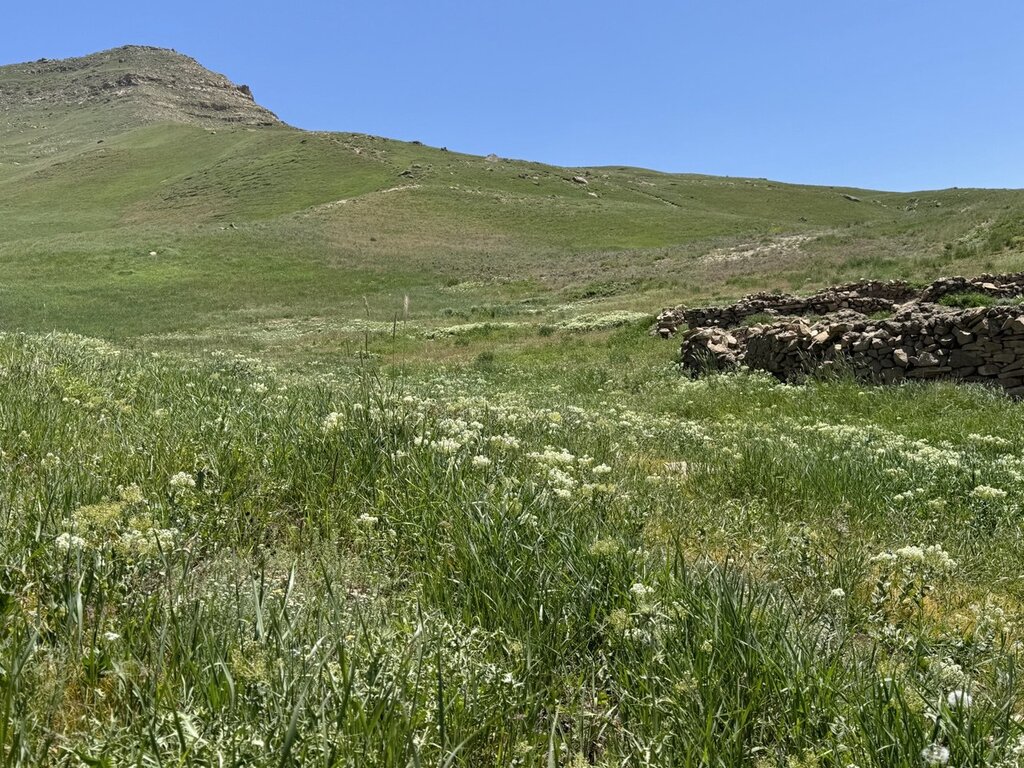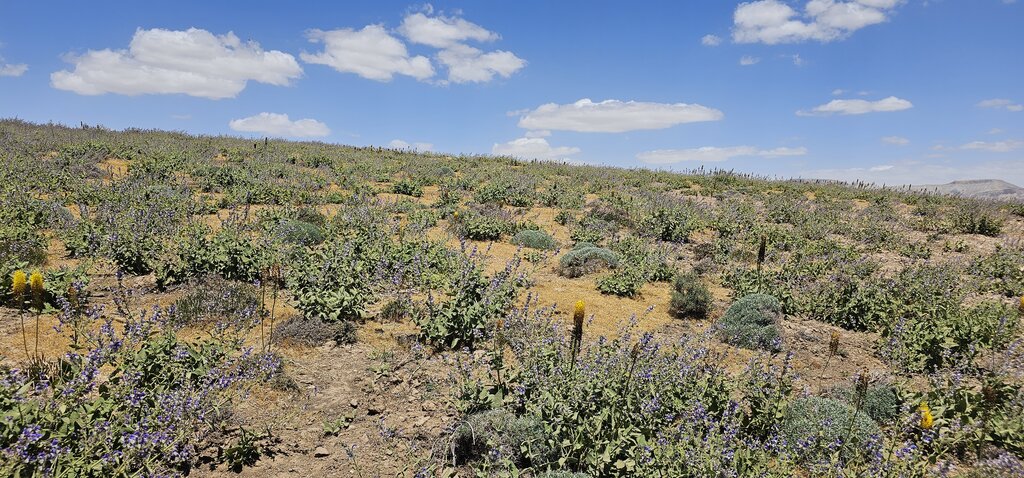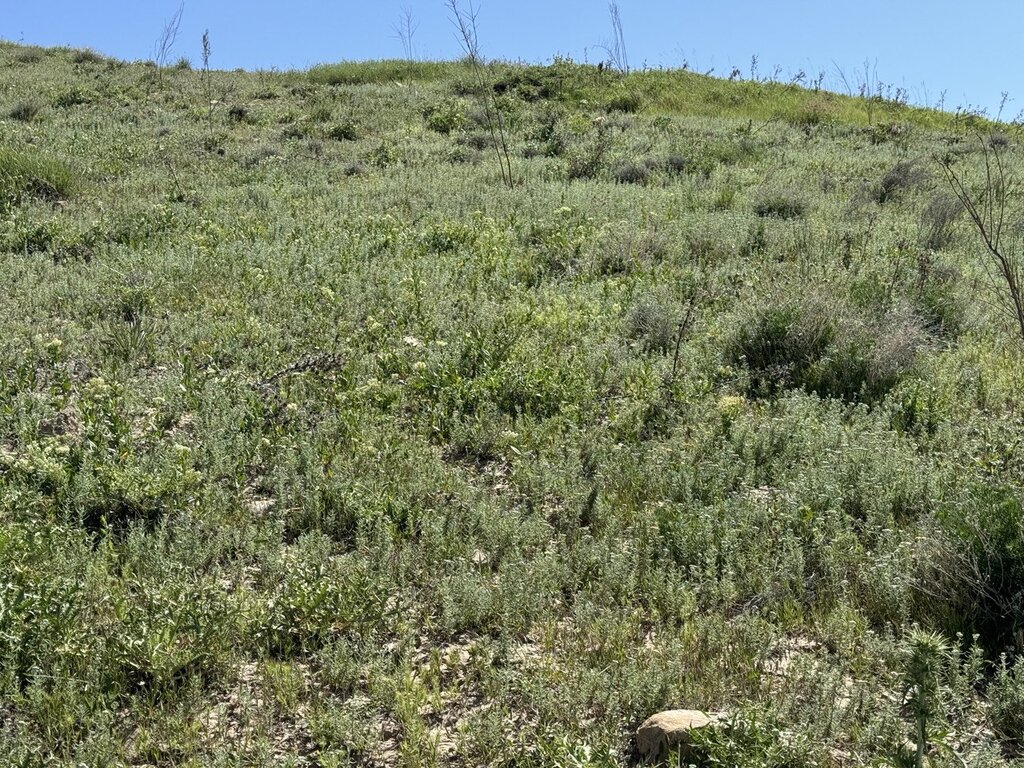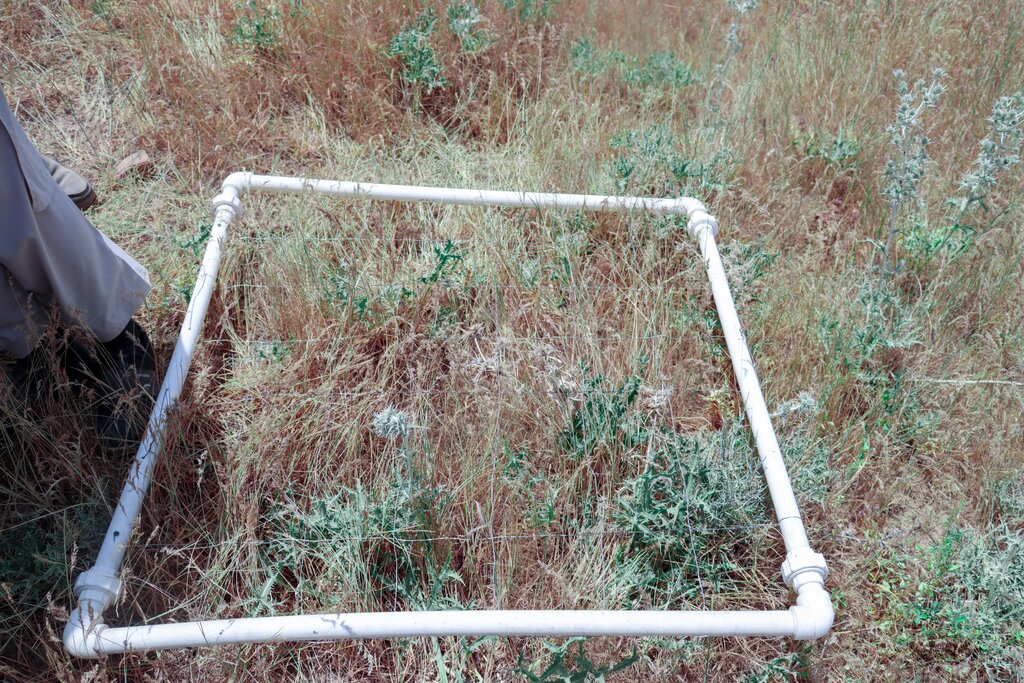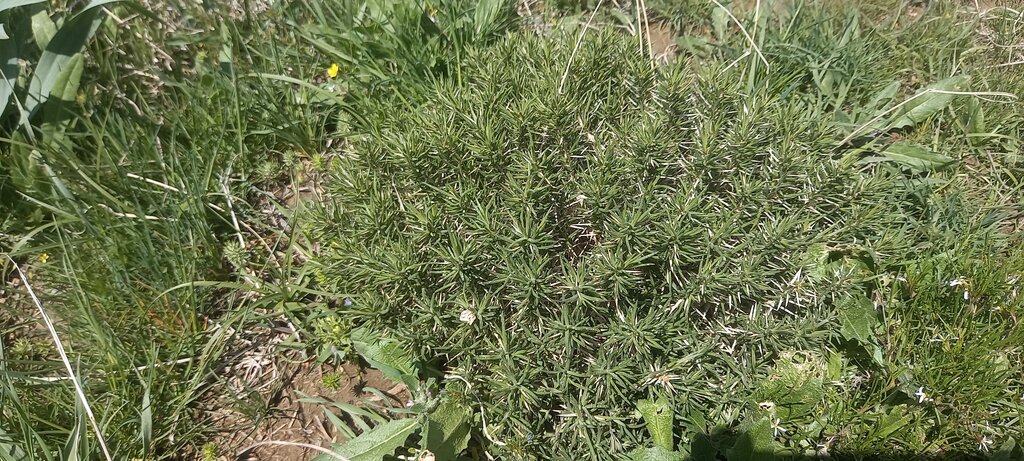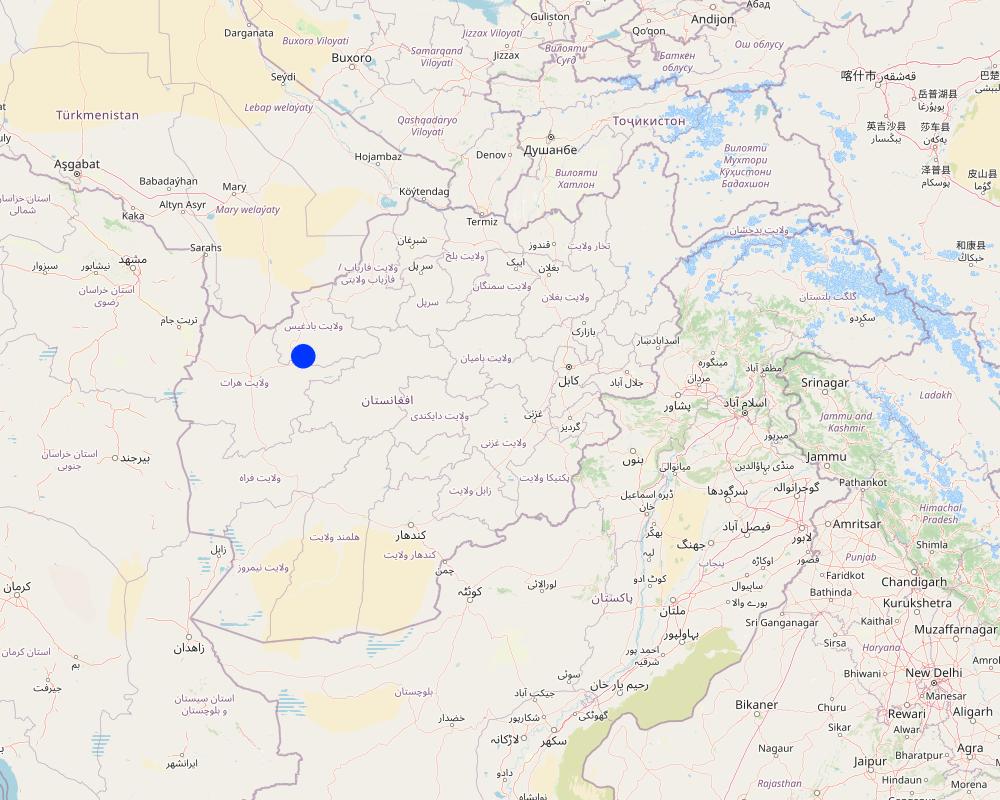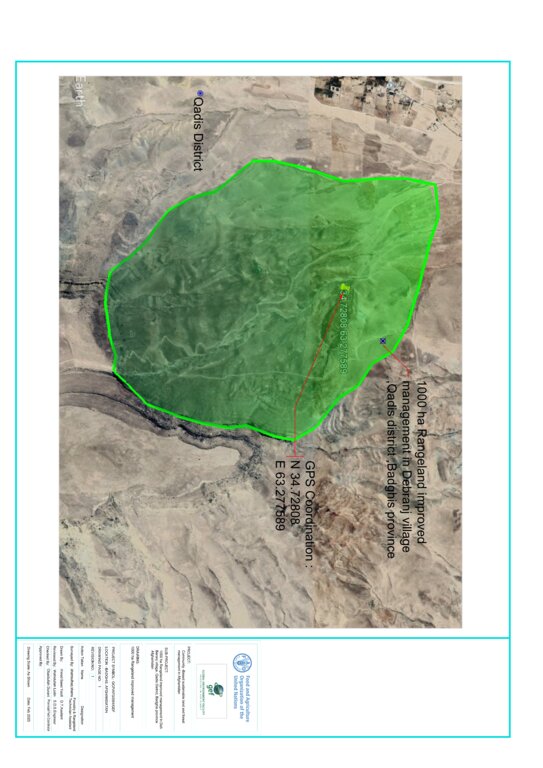Implementing Site Quarantine to reduce rangeland degradation in the highlands of Badghis [阿富汗]
- 创建:
- 更新:
- 编制者: Shamsulhaq Shams
- 编辑者: Mir Wali Khan Lakanwal, Mohammad Mustafa Sahebzada, Obaidullah Durani, Megha bajaj
- 审查者: Rima Mekdaschi Studer, Illias Animon, Muhammad Ishaq Safi
قرنطینه و مدیریت چرا در ارتفاعات بادغیس برای کاهش تخریب مراتع
technologies_7459 - 阿富汗
- Implementing Site Quarantine to reduce rangeland degradation in the highlands of Badghis: March 13, 2025 (inactive)
- Implementing Site Quarantine to reduce rangeland degradation in the highlands of Badghis: March 24, 2025 (inactive)
- Implementing Site Quarantine to reduce rangeland degradation in the highlands of Badghis: May 6, 2025 (public)
查看章节
全部展开 全部收起1. 一般信息
1.2 参与该技术评估和文件编制的资源人员和机构的联系方式
关键资源人
SLM专业人员:
SLM专业人员:
土地使用者:
Akrami Abdul Ghafar
Deh Beranj Rangeland Management Association
阿富汗
土地使用者:
Jami Mula Abdul Rhaman
Deh Beranj Rangeland Management Association
阿富汗
土地使用者:
Baqiri Habibullah
Deh Beranj Rangeland Management Association
阿富汗
土地使用者:
Sadat Serajulhaq
Deh Beranj RMA
阿富汗
有助于对技术进行记录/评估的项目名称(如相关)
Community-based sustainable land and forest management in Afghanistan有助于对技术进行记录/评估的机构名称(如相关)
FAO Afghanistan (FAO Afghanistan) - 阿富汗1.3 关于使用通过WOCAT记录的数据的条件
编制者和关键资源人员接受有关使用通过WOCAT记录数据的条件。:
是
1.4 所述技术的可持续性声明
这里所描述的技术在土地退化方面是否存在问题,导致无法被认为是一种可持续的土地管理技术?:
否
2. SLM技术的说明
2.1 技术简介
技术定义:
Restoring degraded rangelands through quarantine in Qadis district, Badghis Afghanistan.
2.2 技术的详细说明
说明:
The project “Community-based sustainable land and forest management in Afghanistan”, implemented by FAO with the financial support of GEF, aimed to promote biodiversity conservation, climate change mitigation, and rangeland productivity through introducing community-based sustainable land and forest management (SLM/SFM) practices in rangeland and forest areas within five targeted provinces, including Badghis, that benefited rural communities that rely on these ecosystems for their livelihood.
In June 2022, a 1,000-hectare rangeland quarantine area was established to promote the rehabilitation of degraded land and restore the natural vegetation cover. This area was strategically enclosed with clearly marked benchmark boundaries to prevent grazing and ensure its complete protection. By protecting this area from human interference and grazing, the land has been given the opportunity to recover naturally.
The quarantine area has shown remarkable improvements in the health of its ecosystem. Native grasses, shrubs, and bushes have successfully rehabilitated, with noticeable growth and regeneration. The efforts to protect this area have allowed these plants to thrive without the pressure of overgrazing, leading to the revitalization of the local flora.
A significant outcome of the quarantine area is its role as a natural seed bank. Native seeds collected from this rehabilitated land are now being stored and used for reseeding other degraded rangelands. These seeds, adapted to the local environment, have high potential for successful regeneration when used to restore other areas facing similar ecological challenges. This process not only supports the rehabilitation of nearby rangelands but also contributes to the long-term sustainability and resilience of the local ecosystem.
The success of this quarantine area highlights the importance of protective measures and demonstrates the potential for land recovery through strategic interventions. As a result, this area serves as a model for rangeland rehabilitation. The lessons from the technology applied can be a valuable resource for future restoration efforts across the region.
2.3 技术照片
关于照片的一般说明:
Since this area is under rangeland quarantine, we have observed significant changes, such as the natural regeneration of grasses, shrubs, bushes, biodiversity and habitat.
2.4 技术视频
日期:
28/01/2025
位置:
Deh Beranj village, Qadis district, Badghis Afghanistan
摄影师的名字:
Abdullah Kheradmand
2.5 已应用该技术的、本评估所涵盖的国家/地区/地点
国家:
阿富汗
区域/州/省:
Badghis province
有关地点的进一步说明:
Deh Beranj Rangeland Management Association, Qadis district
具体说明该技术的分布:
- 均匀地分布在一个区域
如果技术均匀分布在一个区域,则指定覆盖的区域(单位为平方千米):
10.0
技术现场是否位于永久保护区?:
否
Map
×2.6 实施日期
注明实施年份:
2022
2.7 技术介绍
详细说明该技术是如何引入的:
- 通过项目/外部干预
注释(项目类型等):
GEF-06 SLM project in Afghanistan
3. SLM技术的分类
3.1 该技术的主要目的
- 改良生产
- 减少、预防、恢复土地退化
- 保护生态系统
- 保持/提高生物多样性
- 减缓气候变化及其影响
3.2 应用该技术的当前土地利用类型
同一土地单元内混合使用的土地::
否

牧场
粗放式放牧:
- 半游牧畜牧业
集约放牧/饲料生产:
- 改良牧场
动物类型:
- 绵羊
是否实行作物与牲畜的综合管理?:
否
产品和服务:
- 肉类
- 奶类
品种:
绵羊
计数:
50000
3.4 供水
该技术所应用土地的供水:
- 雨养
注释:
Rainfall occurs in December to April
3.5 该技术所属的SLM组
- 区域封闭(停止使用,支持恢复)
- 畜牧业和牧场管理
- 改良的地面/植被覆盖
3.6 包含该技术的可持续土地管理措施

植物措施
- V1:乔木和灌木覆盖层

管理措施
- M5:物种组成的控制/变化
- M6:废物管理(回收、再利用或减少)
3.7 该技术强调的主要土地退化类型

土壤水蚀
- Wt:表土流失/地表侵蚀

物理性土壤退化
- Pw:水浸

生物性退化
- Bc:植被覆盖的减少
- Bf:火灾的有害影响
- Bs:质量和物种组成/多样性的下降
3.8 防止、减少或恢复土地退化
具体数量名该技术与土地退化有关的目标:
- 减少土地退化
4. 技术规范、实施活动、投入和成本
4.1 该技术的技术图纸
技术规范(与技术图纸相关):
• Green area indicates where grasses regenerated and the GPS shows exact quarantined area.
• Rangeland quarantine was implemented for three years to facilitate the recovery of grasses. By restricting access to degraded areas, we allowed native vegetation to regenerate without disturbance. The grazing exclusion is by social fencing.
• The boundary mark is not a fence but functions as one. Constructed from rocks (1 x 1.5 x 2 meters), the boundary marks are placed every 100 to 200 meters around the rangeland quarantine area to clearly mark its boundaries and prevent or control grazing, ensuring the area remains closed for its recovery.
• Stakeholder involvement through inclusion of local communities in planning and implementation processes.
作者:
Shamsulhaq Shams
日期:
10/12/2024
4.2 有关投入和成本计算的一般信息
具体说明成本和投入是如何计算的:
- 每个技术区域
注明尺寸和面积单位:
1000 Ha
具体说明成本计算所用货币:
- 美元
注明雇用劳工的每日平均工资成本:
5 USD
4.3 技术建立活动
| 活动 | 时间(季度) | |
|---|---|---|
| 1. | Survey and site selection followed by feasibility study | 1st month 10/04/2022 |
| 2. | Preparing construction material (eg. assembling rocks) | 2nd month 08/05/2022 |
| 3. | Construction of boundary marks around the area | 3rd month 01/06/2022 |
| 4. | Capacity building of the target communities | 4th month 05/07/2022 |
| 5. | Hiring guard for patrolling the area | 5th month 01/08/2022 |
4.4 技术建立所需要的费用和投入
| 对投入进行具体说明 | 单位 | 数量 | 单位成本 | 每项投入的总成本 | 土地使用者承担的成本% | |
|---|---|---|---|---|---|---|
| 劳动力 | Skilled labour for construction of boundary mark | person/day | 60.0 | 11.0 | 660.0 | 100.0 |
| 劳动力 | Unskilled labour for construction of boundary mark | person/day | 130.0 | 5.0 | 650.0 | 100.0 |
| 劳动力 | Guard for patrolling the area | person/day | 2.0 | 1015.0 | 2030.0 | 50.0 |
| 施工材料 | Rock | M3 | 100.0 | 1.41 | 141.0 | 100.0 |
| 技术建立所需总成本 | 3481.0 | |||||
| 技术建立总成本,美元 | 3481.0 | |||||
如果土地使用者负担的费用少于100%,请注明由谁负担其余费用:
50% of the costs of guards for patrolling the area was paid by the FAO-GEF project
注释:
Cost of skilled labour for construction of the boundary marks was paid by FAO-GEF project.
4.5 维护/经常性活动
| 活动 | 时间/频率 | |
|---|---|---|
| 1. | Patrolling the area | All seasons/regular |
4.6 维护/经常性活动所需要的费用和投入(每年)
| 对投入进行具体说明 | 单位 | 数量 | 单位成本 | 每项投入的总成本 | 土地使用者承担的成本% | |
|---|---|---|---|---|---|---|
| 劳动力 | Guard for patrolling the area (second year) | person/year | 2.0 | 1015.0 | 2030.0 | 50.0 |
| 技术维护所需总成本 | 2030.0 | |||||
| 技术维护总成本,美元 | 2030.0 | |||||
4.7 影响成本的最重要因素
描述影响成本的最决定性因素:
Skilled and unskilled labour
5. 自然和人文环境
5.1 气候
年降雨量
- < 250毫米
- 251-500毫米
- 501-750毫米
- 751-1,000毫米
- 1,001-1,500毫米
- 1,501-2,000毫米
- 2,001-3,000毫米
- 3,001-4,000毫米
- > 4,000毫米
指定年平均降雨量(若已知),单位为mm:
250.00
有关降雨的规范/注释:
Winter (January, February, March)
Dry periods start from May till November
农业气候带
- 半干旱
Annual temperature is 25 degrees
5.2 地形
平均坡度:
- 水平(0-2%)
- 缓降(3-5%)
- 平缓(6-10%)
- 滚坡(11-15%)
- 崎岖(16-30%)
- 陡峭(31-60%)
- 非常陡峭(>60%)
地形:
- 高原/平原
- 山脊
- 山坡
- 山地斜坡
- 麓坡
- 谷底
垂直分布带:
- 0-100 m a.s.l.
- 101-500 m a.s.l.
- 501-1,000 m a.s.l.
- 1,001-1,500 m a.s.l.
- 1,501-2,000 m a.s.l.
- 2,001-2,500 m a.s.l.
- 2,501-3,000 m a.s.l.
- 3,001-4,000 m a.s.l.
- > 4,000 m a.s.l.
说明该技术是否专门应用于:
- 凹陷情况
关于地形的注释和进一步规范:
1800 m above sea level and slope angle is 20 %
5.3 土壤
平均土层深度:
- 非常浅(0-20厘米)
- 浅(21-50厘米)
- 中等深度(51-80厘米)
- 深(81-120厘米)
- 非常深(> 120厘米)
土壤质地(表土):
- 细粒/重质(粘土)
土壤质地(地表以下> 20厘米):
- 细粒/重质(粘土)
表土有机质:
- 低(<1%)
5.4 水资源可用性和质量
地下水位表:
> 50米
地表水的可用性:
中等
水质(未处理):
良好饮用水
水质请参考::
地下水和地表水
水的盐度有问题吗?:
否
该区域正在发生洪水吗?:
否
5.5 生物多样性
物种多样性:
- 高
栖息地多样性:
- 中等
关于生物多样性的注释和进一步规范:
The rangelands are characterized by flora diversity and likely host a variety of plant species that are adapted to arid conditions. These include drought-resistant grasses like Eragrostis species, shrubs like Acantholimon caryophllaceum, Artemisia and some endemic plant species unique to the region (Achillea nabilis, Cardaria draba, Cousinia resinosa).
5.6 应用该技术的土地使用者的特征
定栖或游牧:
- 半游牧的
生产系统的市场定位:
- 混合(生计/商业)
非农收入:
- 低于全部收入的10%
相对财富水平:
- 贫瘠
个人或集体:
- 团体/社区
机械化水平:
- 手工作业
性别:
- 男人
土地使用者的年龄:
- 中年人
5.7 应用该技术的土地使用者使用的平均土地面积
- < 0.5 公顷
- 0.5-1 公顷
- 1-2 公顷
- 2-5公顷
- 5-15公顷
- 15-50公顷
- 50-100公顷
- 100-500公顷
- 500-1,000公顷
- 1,000-10,000公顷
- > 10,000公顷
这被认为是小规模、中规模还是大规模的(参照当地实际情况)?:
- 小规模的
5.8 土地所有权、土地使用权和水使用权
土地所有权:
- 社区/村庄
土地使用权:
- 社区(有组织)
用水权:
- 社区(有组织)
土地使用权是否基于传统的法律制度?:
是
具体说明:
Traditional land use rights
注释:
Land use rights are held collectively by communities, reflecting a communal approach to resource management.
5.9 进入服务和基础设施的通道
健康:
- 贫瘠
- 适度的
- 好
教育:
- 贫瘠
- 适度的
- 好
技术援助:
- 贫瘠
- 适度的
- 好
就业(例如非农):
- 贫瘠
- 适度的
- 好
市场:
- 贫瘠
- 适度的
- 好
能源:
- 贫瘠
- 适度的
- 好
道路和交通:
- 贫瘠
- 适度的
- 好
饮用水和卫生设施:
- 贫瘠
- 适度的
- 好
金融服务:
- 贫瘠
- 适度的
- 好
6. 影响和结论性说明
6.1 该技术的现场影响
社会经济效应
生产
饲料生产
SLM之前的数量:
500 kg fodder/ hectare
SLM之后的数量:
900 kg fodder/hectare
注释/具体说明:
Preventing overgrazing helps maintain plant cover and allows for recovery periods, leading to increased biomass production.
畜牧生产
SLM之前的数量:
0.5 liter per sheep/day
SLM之后的数量:
1 liter per sheep/day
注释/具体说明:
Enhancing the quality and availability of forage provid sheep with a more nutritious diet, which directly impacts milk production.
水资源可用性和质量
饮用水的质量
SLM之前的数量:
Contaminated water with minerals
SLM之后的数量:
Leading to clearer and cleaner water
注释/具体说明:
Effective rangeland management practices enhance the overall health of the ecosystem, leading to improved drinking water quality through better infiltration due to better soil cover and less water runoff.
社会文化影响
食品安全/自给自足
注释/具体说明:
Sustainable rangeland management supports local economies by providing livelihoods through livestock production, which can improve food access and self-sufficiency in communities.
健康状况
SLM之前的数量:
Less nutritious animal products
SLM之后的数量:
More nutritious animal products
注释/具体说明:
Enhanced forage quality leads to healthier livestock, which provides better quality meat and dairy products, contributing to improved nutrition for communities.
SLM/土地退化知识
SLM之前的数量:
Little capacity building
SLM之后的数量:
Capacity building for 500 members of the Rangeland Management Association
注释/具体说明:
Training programs for farmers and land managers, increasing their knowledge about sustainable practices and land conservation techniques.
生态影响
水循环/径流
地表径流
注释/具体说明:
Rangeland improvement practices can significantly reduce surface runoff, enhance soil health, and improve water quality
多余水的排放
注释/具体说明:
More efficient excess water drainage, enhancing soil structure, reducing waterlogging, and promoting overall ecological health.
土壤
土壤覆盖层
SLM之前的数量:
20% soil cover
SLM之后的数量:
80-90% soil cover
注释/具体说明:
Enhanced soil cover leads to healthier ecosystems, improved soil conditions, and increased biodiversity.
生物多样性:植被、动物
植被覆盖
SLM之前的数量:
20%
SLM之后的数量:
80-90%
注释/具体说明:
Enhanced vegetation cover leads to healthier ecosystems, improved soil conditions, and increased biodiversity
生物量/地上C
SLM之前的数量:
20-30% biomass
SLM之后的数量:
80-90% biomass
注释/具体说明:
Rangeland improvement practices significantly boost biomass and above-ground carbon levels, enhancing ecosystem productivity and contributing to carbon sequestration efforts.
植物多样性
SLM之前的数量:
60/plants per square meter
SLM之后的数量:
200/plants per square meter
注释/具体说明:
Enhanced plant diversity leads to healthier ecosystems, increased resilience, and improved overall productivity.
有益物种
SLM之前的数量:
Limited Beneficial Species
SLM之后的数量:
Increased Beneficial Species
注释/具体说明:
Rangeland improvement practices significantly boost the presence and impact of beneficial species, enhancing soil health, ecosystem stability, and overall productivity.
减少气候和灾害风险
干旱影响
SLM之前的数量:
500 kg fodder/ha
SLM之后的数量:
800 kg fodder/ ha
注释/具体说明:
Rangeland improvement practices significantly mitigate the impacts of drought, enhancing soil moisture retention, vegetation resilience by enhancing the land's ability to retain moisture and support vegetation growth, and overall ecosystem stability.
碳和温室气体的排放
SLM之前的数量:
80000 m3/ winter season
SLM之后的数量:
20000 m3/ winter season
注释/具体说明:
Healthy, diverse plant communities capture and sequester more carbon dioxide through photosynthesis, contributing to greater carbon sequestration and contributing to climate change mitigation efforts.
对现场影响的评估(测量)进行具体说明:
N/A
6.2 该技术的场外影响已经显现
下游洪水
SLM之前的数量:
10-12 times /year
SLM之后的数量:
Zero floods per year
注释/具体说明:
Risk and impact of downstream flooding is significantly reduced by enhancing vegetation cover, improving soil health, and promoting better water management.
风力搬运沉积物
SLM之前的数量:
more sediment transport
SLM之后的数量:
Zero sediment transport
注释/具体说明:
With vegetation cover, there is significantly less sediment being transported by wind
温室气体的影响
SLM之前的数量:
20 tons CO2 removed/year
SLM之后的数量:
50 tons CO2 removed/year
注释/具体说明:
Healthy rangelands help absorb more carbon in plants and soil, which lowers the amount of CO₂ in the atmosphere. When these lands are grazed properly, they allow perennial and annual grasses to regrow. This regrowth not only captures more carbon but also improves soil health.
对场外影响(测量)的评估进行具体说明:
N/A
6.3 技术对渐变气候以及与气候相关的极端情况/灾害的暴露和敏感性(土地使用者认为的极端情况/灾害)
渐变气候
渐变气候
| 季节 | 增加或减少 | 该技术是如何应对的? | |
|---|---|---|---|
| 年温度 | 减少 | 适度 | |
| 年降雨量 | 增加 | 适度 |
气候有关的极端情况(灾害)
气象灾害
| 该技术是如何应对的? | |
|---|---|
| 局地风暴 | 适度 |
气候灾害
| 该技术是如何应对的? | |
|---|---|
| 热浪 | 适度 |
| 干旱 | 适度 |
水文灾害
| 该技术是如何应对的? | |
|---|---|
| 山洪暴发 | 适度 |
6.4 成本效益分析
技术收益与技术建立成本相比如何(从土地使用者的角度看)?
短期回报:
稍微积极
长期回报:
非常积极
技术收益与技术维护成本/经常性成本相比如何(从土地使用者的角度看)?
短期回报:
积极
长期回报:
非常积极
注释:
Improved rangelands often lead to higher forage yields, supporting larger and healthier livestock populations. This can result in increased income for land users.
6.5 技术采用
- 单例/实验
在所有采用这项技术的人当中,有多少人是自发的,即未获得任何物质奖励/付款?:
- 0-10%
6.6 适应
最近是否对该技术进行了修改以适应不断变化的条件?:
否
6.7 该技术的优点/长处/机会
| 土地使用者眼中的长处/优势/机会 |
|---|
| Rangeland quarantine allow for better management of pasture resources leading to improved pasture and grass quality. |
| Rangeland quarantine increased productivity can maximize the land's carrying capacity leading to higher livestock productivity per unit area. |
| Rangeland quarantine helps prevent overgrazing, reduces parasite loads, minimizes soil compaction, and allows for more natural feeding behaviors, all of which contribute to overall animal health. |
| Reduce greenhouse gas emissions through carbon sequestration. |
| Properly managed rangeland quarantine can promote biodiversity by creating varied habitats and supporting a range of plant and animal species. |
| Implementing rangeland quarantine can lead to knowledge transfer among farmers, researchers, and agricultural extension services, fostering innovation and best practices in sustainable land management. |
6.8 技术的弱点/缺点/风险及其克服方法
| 土地使用者认为的弱点/缺点/风险 | 如何克服它们? |
|---|---|
| Ensuring the right number of animals on each grazing area can be challenging, leading to risks of overgrazing or underutilization. | Stocking rate management. |
| Rangeland quarantine can lead to social conflicts among different user groups, such as conflicting interests between livestock owners, conservationists, and indigenous communities. | Facilitating dialogue among stakeholders, promoting collaborative rangeland management approaches, respecting traditional land tenure systems, and fostering community-based conflict resolution mechanisms can help manage. |
| 编制者或其他关键资源人员认为的弱点/缺点/风险 | 如何克服它们? |
|---|---|
| When grazing animals are quarantined, their numbers may increase in certain areas, leading to overgrazing. This can result in habitat degradation and loss of plant diversity. | Implement managed grazing systems to control population densities and prevent overgrazing. This can include rotational grazing practices. |
7. 参考和链接
7.1 信息的方法/来源
- 实地考察、实地调查
5
- 与土地使用者的访谈
12
- 与SLM专业人员/专家的访谈
2
- 根据报告和其他现有文档进行编译
2
(现场)数据是什么时候汇编的?:
23/10/2024
7.4 一般注释
This questionnaire serves as an ideal model to showcase the work modality and shared experiences with other regions. By evaluating this type of work model, individuals interested in this field can easily adjust their activities and increase their chances of success.
链接和模块
全部展开 全部收起链接
无链接
模块
无模块


